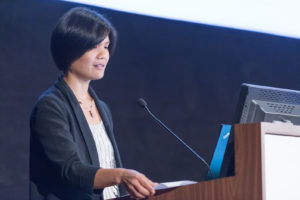Reprinted from BWH Clinical Research News Sept 2019
At the Brigham, researchers are taking approaches to tuberculosis (TB) treatment, looking at this notorious infectious disease from genetic, chemical and public health angles. Many researchers from the Brigham work in affiliation with Socios En Salud (Partners In Health) in Peru, as well as tackling research at home and at other global locations.
Developing Sustainable Systems and Increasing Access

One researcher who focuses on TB, Courtney Yuen, PhD, associate epidemiologist in the Division of Global Health Equity, obtained her doctorate in chemistry, initially thinking she would pursue a career focused on basic science. But upon realizing the length of time it can take research in a lab to impact people and their health, she decided to retrain as an epidemiologist at the Centers for Disease Control and Prevention (CDC), in hopes of seeing the more direct effect her work could have on people’s welfare.
“I wanted to focus my research on an area that affects vulnerable populations, and TB falls into this category. TB is a disease of inequality,” Yuen said. “In the U.S., it disproportionately affects people in homeless shelters or prison, as well as immigrants and refugees. Globally, it tends to affect people in countries that don’t have as many resources and are at the center of the AIDS epidemic.”
Yuen has also done a lot of work with Socios En Salud in Peru, helping to build a health system capable of diagnosing TB faster and providing preventative treatment for people who have been exposed to the disease. She is currently working on a project that brings TB screening directly into local communities with a van that has X-ray equipment on board. This type of strategy was prominent in the U.S. in the 1940s but is being used in Peru for the first time. So far, the project has provided screening for almost 30,000 people in northern Lima.
Recently, Yuen collaborated with Interactive Research and Development (IRD) Pakistan, an organization that focuses on screening, treatment and prevention of TB in underserved areas. Yuen has worked with her IRD Pakistan collaborators on a study addressing the question of appropriate medication dosing for children infected with TB.
Active Infection, Transference and the Genetic Connection
Megan Murray, MD, MPH, ScD, the Ronda Stryker and William Johnston Professor of Global Healthand the director of research in Division of Global Health Equity, has also worked extensively on TB in Peru, including collaborating on a large study that looked at the transmission of TB from 2008 to 2012. The study enrolled 18,000 people total, 4,500 of whom had an active TB infection, and examined how many people with an active infection transferred TB to a household contact.
 “It’s rewarding to make research advances that offer practical benefit for the treatment of people with TB,” said Murray. “It’s also been great to work with not only Socios En Salud, but also in other countries where we can help train people and develop local research capacity.”
“It’s rewarding to make research advances that offer practical benefit for the treatment of people with TB,” said Murray. “It’s also been great to work with not only Socios En Salud, but also in other countries where we can help train people and develop local research capacity.”
A huge percentage of people worldwide are infected with TB, but only a small portion develop an active TB infection. Drawing from the information taken from Murray’s four-year study, Soumya Raychaudhuri, MD, PhD, an investigator in the divisions of Genetics and Rheumatology, worked in collaboration with Murray and other Brigham investigators on a study that looked at genetic factors that can affect who becomes actively infected with TB.
To better understand if some people may have a genetic predisposition to developing an infection, the researchers compared genetic markers in people who had been infected with TB but had not developed an active TB infection to those who had an active TB infection.
The team identified a gene locus that appeared to be associated with active TB infection. They also concluded that this predisposition to active TB infection is highly heritable. The study has important ramifications, as it opens up the potential for being able to tell who might be at risk for developing an active TB infection. It also shows a possibility for identifying new ways to treat the disease.
“Finding genes involved in susceptibility to disease can point us toward important pathways and cell types that are essential for controlling it,” said Raychaudhuri. “For studies like this, which point to key TB genes, the hope is that they can give us the opportunity to develop therapeutics to enhance the immune system and prevent or clear TB in infected people.”
Looking at Lipids: Chemistry at Play in a TB Infection
Another author who collaborated with Raychaudhuri on his study, Branch Moody, MD, an investigator in the Division of Rheumatology, Immunology and Allergy, has conducted a recent study looking at TB disease from a biochemical perspective, asking what makes M. tuberculosis so much more dangerous than other mycobacteria.
“Of the many species of mycobacteria, only one type of mycobacterium, M. tuberculosis, has infected more than one-third of the Earth’s population and kills more than any other,” said Moody. “A relatively straightforward approach is to compare M. tuberculosis to another less deadly mycobacterium. This is essentially what we did in our study to reveal the underlying biochemistry that distinguishes this deadly strain.”
The study looked at thousands of lipids and identified one compound present in M. tuberculosis but not in other mycobacteria: 1-tuberculosinyladenosine (1-TbAd). Moody and his colleagues first thought that this compound might act as a signaler, as adenosine often does. However, after a two-year investigation, they discovered that 1-TbAd served the basic function of as an antacid, coating M. tuberculosis in order to stop macrophages from digesting it with acid. This could begin to answer the question of just what makes M. tuberculosis so much more deadly than other mycobacteria.
If the function of 1-TbAd indeed contributes to making TB such a deadly infection, their work could lead to new studies of different ways to approach the treatment of TB. Since this compound seems to be unique to M. tuberculosis, Moody has also been funded for a follow-up project that aims to identify this compound or specific antibodies in a person’s urine sample, with the goal of providing a quick and efficient way to screen for TB.
As Brigham researchers and their colleagues and collaborators the world over continue to rigorously examine TB from new angles, the insights they glean may lead to a better understanding and better ways to prevent and treat the disease.
